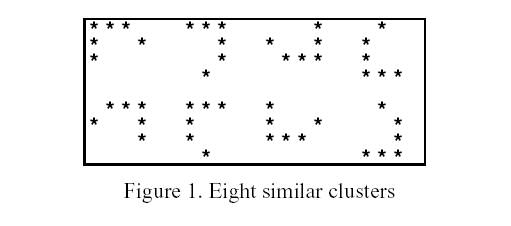Starry Night
High up in the night sky, the shining stars appear in clusters of various shapes. A cluster is a non-empty group of neighbouring stars, adjacent in horizontal, vertical or diagonal direction. A cluster cannot be a part of a larger cluster.
Clusters may be similar. Two clusters are similar if they have the same shape and number of stars, irrespective of their orientation. In general, the number of possible orientations for a cluster is eight, as Figure 1 exemplifies.

The night sky is represented by a sky map, which is a two-dimensional matrix of 0's and 1's. A cell contains the digit 1 if it has a star, and the digit 0 otherwise.
Given a sky map, mark all the clusters with lower case letters. Similar clusters must be marked with the same letter; non-similar clusters must be marked with different letters. You mark a cluster with a lower case letter by replacing every 1 in the cluster by that lower case letter. The order of allocation of letters depends on the first appearance of different clusters, from top to bottom and from left to right.
Your program is to read from standard input. The first two lines contain, respectively, the width W and the height H of a sky map. The sky map is given in the following H lines, of W characters each.
0 <= W (width of the sky map) <= 100
0 <= H (height of the sky map) <= 100
0 <= Number of clusters <= 500
0 <= Number of non-similar clusters <= 26 (a..z)
1 <= Number of stars per cluster <= 160
Your program is to write to standard output. The output contains the same map as the input, except that the clusters are marked as described above.
23 15 10001000000000010000000 01111100011111000101101 01000000010001000111111 00000000010101000101111 00000111010001000000000 00001001011111000000000 10000001000000000000000 00101000000111110010000 00001000000100010011111 00000001110101010100010 00000100110100010000000 00010001110111110000000 00100001110000000100000 00001000100001000100101 00000001110001000111000
a000a0000000000b0000000 0aaaaa000ccccc000d0dd0d 0a0000000c000c000dddddd 000000000c0b0c000d0dddd 00000eee0c000c000000000 0000e00e0ccccc000000000 b000000e000000000000000 00b0f000000ccccc00a0000 0000f000000c000c00aaaaa 0000000ddd0c0b0c0a000a0 00000b00dd0c000c0000000 000g000ddd0ccccc0000000 00g0000ddd0000000e00000 0000b000d0000f000e00e0b 0000000ddd000f000eee000
Just to make it clearer, notice that this sample input corresponds to the following picture of the sky.

Notice that this sample output corresponds to the following picture.

Submit
